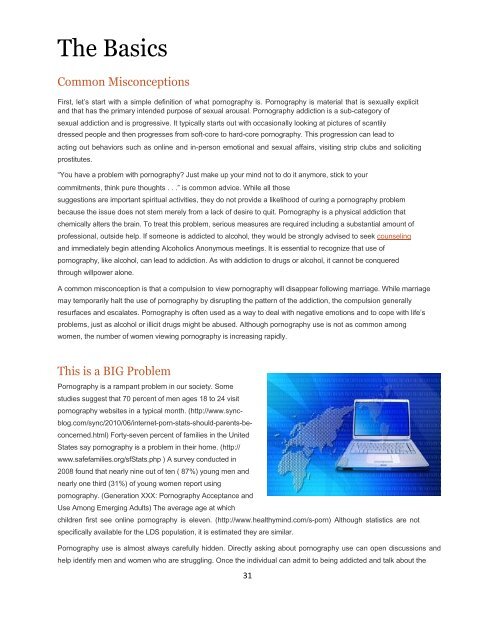Safety Net
Safety Net
Safety Net
You also want an ePaper? Increase the reach of your titles
YUMPU automatically turns print PDFs into web optimized ePapers that Google loves.
The Basics<br />
Common Misconceptions<br />
First, let’s start with a simple definition of what pornography is. Pornography is material that is sexually explicit<br />
and that has the primary intended purpose of sexual arousal. Pornography addiction is a sub-category of<br />
sexual addiction and is progressive. It typically starts out with occasionally looking at pictures of scantily<br />
dressed people and then progresses from soft-core to hard-core pornography. This progression can lead to<br />
acting out behaviors such as online and in-person emotional and sexual affairs, visiting strip clubs and soliciting<br />
prostitutes.<br />
“You have a problem with pornography? Just make up your mind not to do it anymore, stick to your<br />
commitments, think pure thoughts . . .” is common advice. While all those<br />
suggestions are important spiritual activities, they do not provide a likelihood of curing a pornography problem<br />
because the issue does not stem merely from a lack of desire to quit. Pornography is a physical addiction that<br />
chemically alters the brain. To treat this problem, serious measures are required including a substantial amount of<br />
professional, outside help. If someone is addicted to alcohol, they would be strongly advised to seek counseling<br />
and immediately begin attending Alcoholics Anonymous meetings. It is essential to recognize that use of<br />
pornography, like alcohol, can lead to addiction. As with addiction to drugs or alcohol, it cannot be conquered<br />
through willpower alone.<br />
A common misconception is that a compulsion to view pornography will disappear following marriage. While marriage<br />
may temporarily halt the use of pornography by disrupting the pattern of the addiction, the compulsion generally<br />
resurfaces and escalates. Pornography is often used as a way to deal with negative emotions and to cope with life’s<br />
problems, just as alcohol or illicit drugs might be abused. Although pornography use is not as common among<br />
women, the number of women viewing pornography is increasing rapidly.<br />
This is a BIG Problem<br />
Pornography is a rampant problem in our society. Some<br />
studies suggest that 70 percent of men ages 18 to 24 visit<br />
pornography websites in a typical month. (http://www.sync-<br />
blog.com/sync/2010/06/internet-porn-stats-should-parents-be-<br />
concerned.html) Forty-seven percent of families in the United<br />
States say pornography is a problem in their home. (http://<br />
www.safefamilies.org/sfStats.php ) A survey conducted in<br />
2008 found that nearly nine out of ten ( 87%) young men and<br />
nearly one third (31%) of young women report using<br />
pornography. (Generation XXX: Pornography Acceptance and<br />
Use Among Emerging Adults) The average age at which<br />
children first see online pornography is eleven. (http://www.healthymind.com/s-porn) Although statistics are not<br />
specifically available for the LDS population, it is estimated they are similar.<br />
Pornography use is almost always carefully hidden. Directly asking about pornography use can open discussions and<br />
help identify men and women who are struggling. Once the individual can admit to being addicted and talk about the<br />
31


